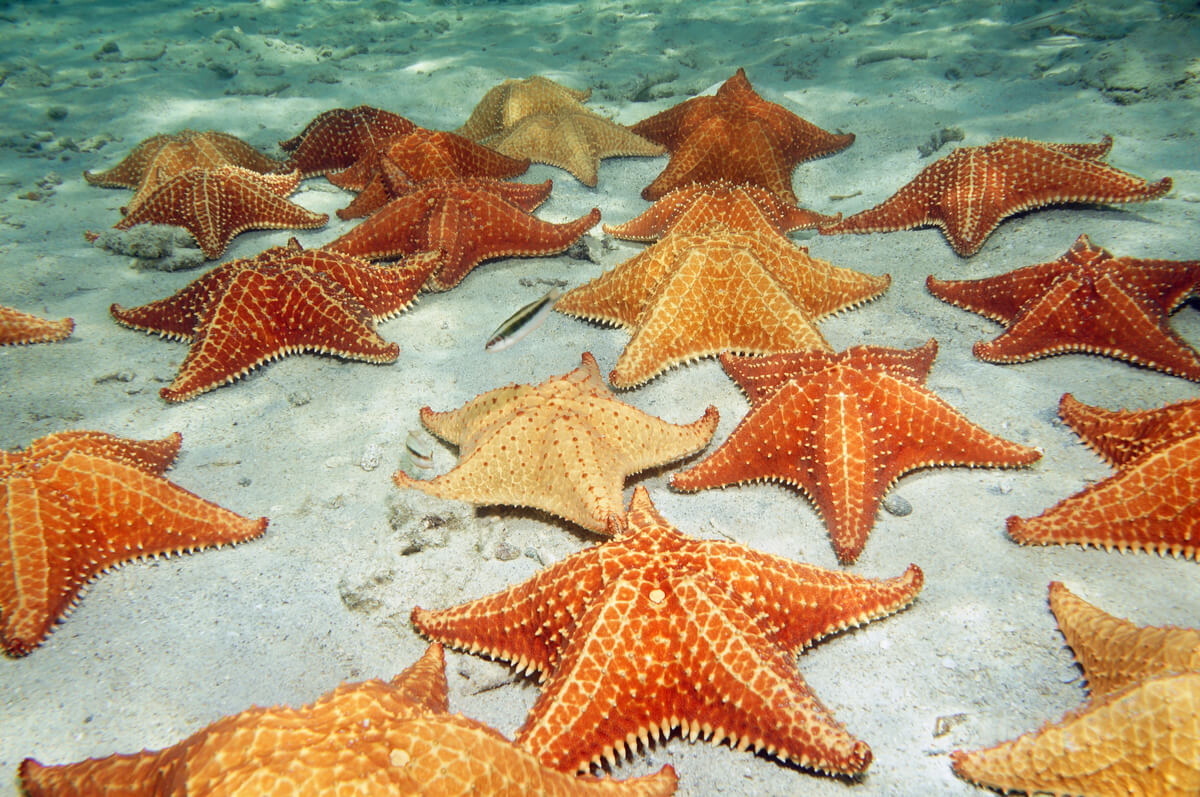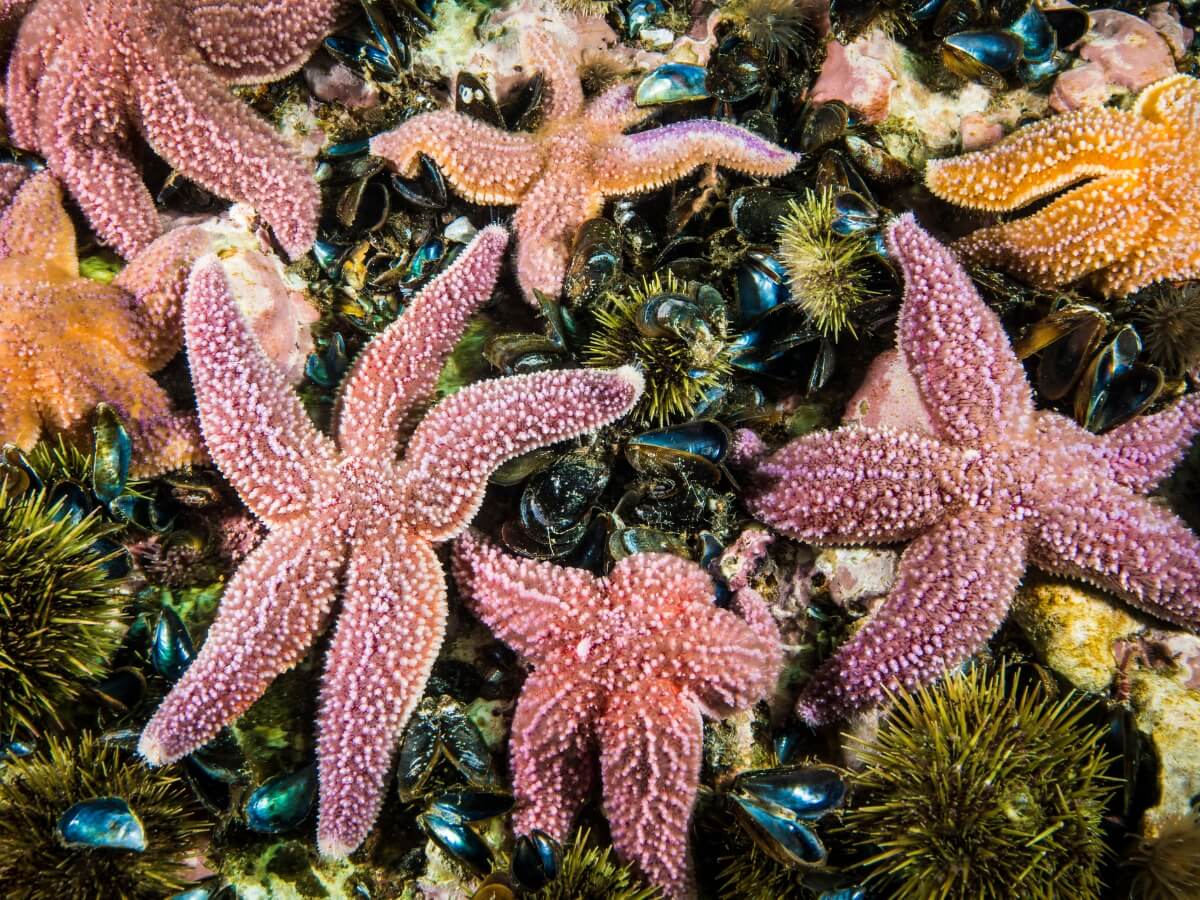How Do Starfish Breathe?


Reviewed and approved by the biologist Samuel Sanchez
Starfish are part of the Asteroidea class of the echinoderm family, distributed throughout all the world’s oceans. These invertebrates have an amazing and wonderful life system. One of its surprises lies in how starfish breathe.
Here you can learn about this process, other characteristics and how to contribute to the conservation of these wonderful aquatic beings. Don’t miss it.
Before answering how do starfish breathe
The characteristics and behavior of these beings are so surprising. Before learning how starfish breathe though, it’ll be fascinating to learn other amazing things about them. Let’s go!
They’re full of thorns
Echinoderm means ‘prickly skin’. Most starfish have rows of tiny spines on top to protect themselves from predators. In addition, some have shorter spines on their underside, along with their tubular legs.
Do they move?
Starfish move relatively slowly, so they can’t be seen swimming or even moving very clearly. Experts say that if they’re observed long enough, it can be discovered that they do indeed move, by means of special structures called tube feet.
Each starfish has 200 to 300 of these tentacles. They’re found on their underside, and are used to grip surfaces and move around the ocean.

Its reproduction and regenerative capacity
Starfish can reproduce through a microscopic larval stage that they release into the water over weeks or months — depending on the species. This intermediate form settles down and turns into little starfish in order to keep growing.
In addition to producing this larval stage, some stars may also simply decide to split in two to reproduce asexually. When conditions are right and the starfish feels the need to increase the size of its population, it will do so by dividing in half, to grow a new body.
This phenomenon gives rise to their ability to regenerate, because if a fish attacks them and grabs them by one of their arms, the starfish can release that limb – through a process called autotomy or autoamputation – since it will grow back on its own.
Its sight
If you look at starfish, you can see that they have red dots or eyespots on the end of their arms, which help them to detect shades of intensity. So if you move your hand over them, they will notice that the light has dimmed and that something nearby is moving.
Their circulatory system, related to how starfish breathe
Stars have a very unusual circulatory system, as they don’t pump blood around their bodies. Instead, they use seawater and a complex vascular water system to stay alive. Their tube feet — also used for movement and breathing — are an important part of this circulatory system.
How do starfish breathe?
Starfish don’t use lungs to breathe. Most of the oxygen is obtained from the water that passes through the tube feet and the papules or gills of the skin, small projections near the base of the spines.
In addition, these invertebrates breathe through the oxygen present in the water. If they’re removed from their habitat, they can’t carry out the gas exchange for their life cycle, they become poisoned with carbon dioxide or monoxide, and they drown. In 3 or 5 minutes out of the water – depending on the species – they die, say experts on the subject.
Some tourists and tourism companies encourage people to take starfish out of the water to take pictures of them. This inappropriate behavior can cause their death, either due to intoxication or stress, as taking them out of the water, stacking them up and putting them together is subjecting them to conditions that are alien to their way of life.
Biologists – who know how to treat these animals – take starfish out of the water for research purposes and only once for a few seconds. In addition, they hold them with gloves so as not to cause damage with the pH of the skin or with sun protection products.
How to protect starfish?
The life expectancy of a starfish varies according to its species. Some live 10 years and others can remain in the environment for up to 34 years.
As you can see, the answer to how starfish breathe is somewhat surprising, but some experts claim that, due to their way of capturing oxygen (by pumping water directly into their bodies through the aquifer vascular system) they’re more vulnerable to all forms of water pollution.
Because of this, starfish have very little ability to filter out toxins and pollutants, such as oil spills.
In addition, there’s the constant situation that the starfish experience due to human actions, because, when they get too close to the coast, they’re in danger due to the tourists. If you want to look after this wonderful aquatic being, we invite you to follow these tips:
- Observe the stars from outside the water or from inside with a mask, without any need to remove them from their habitat or touch them.
- Don’t buy products that exploit marine life, such as coral jewelry, starfish ornaments or items that come from turtles, sharks or whales, recommends National Geographic.
- Get informed about life in the oceans and share what you learn.

It is important that we contribute to preserving starfish and not contributing more to their extinction. Being able to see them is a privilege that we’ll be able to preserve for generations if we take care of them and respect them.
Starfish are part of the Asteroidea class of the echinoderm family, distributed throughout all the world’s oceans. These invertebrates have an amazing and wonderful life system. One of its surprises lies in how starfish breathe.
Here you can learn about this process, other characteristics and how to contribute to the conservation of these wonderful aquatic beings. Don’t miss it.
Before answering how do starfish breathe
The characteristics and behavior of these beings are so surprising. Before learning how starfish breathe though, it’ll be fascinating to learn other amazing things about them. Let’s go!
They’re full of thorns
Echinoderm means ‘prickly skin’. Most starfish have rows of tiny spines on top to protect themselves from predators. In addition, some have shorter spines on their underside, along with their tubular legs.
Do they move?
Starfish move relatively slowly, so they can’t be seen swimming or even moving very clearly. Experts say that if they’re observed long enough, it can be discovered that they do indeed move, by means of special structures called tube feet.
Each starfish has 200 to 300 of these tentacles. They’re found on their underside, and are used to grip surfaces and move around the ocean.

Its reproduction and regenerative capacity
Starfish can reproduce through a microscopic larval stage that they release into the water over weeks or months — depending on the species. This intermediate form settles down and turns into little starfish in order to keep growing.
In addition to producing this larval stage, some stars may also simply decide to split in two to reproduce asexually. When conditions are right and the starfish feels the need to increase the size of its population, it will do so by dividing in half, to grow a new body.
This phenomenon gives rise to their ability to regenerate, because if a fish attacks them and grabs them by one of their arms, the starfish can release that limb – through a process called autotomy or autoamputation – since it will grow back on its own.
Its sight
If you look at starfish, you can see that they have red dots or eyespots on the end of their arms, which help them to detect shades of intensity. So if you move your hand over them, they will notice that the light has dimmed and that something nearby is moving.
Their circulatory system, related to how starfish breathe
Stars have a very unusual circulatory system, as they don’t pump blood around their bodies. Instead, they use seawater and a complex vascular water system to stay alive. Their tube feet — also used for movement and breathing — are an important part of this circulatory system.
How do starfish breathe?
Starfish don’t use lungs to breathe. Most of the oxygen is obtained from the water that passes through the tube feet and the papules or gills of the skin, small projections near the base of the spines.
In addition, these invertebrates breathe through the oxygen present in the water. If they’re removed from their habitat, they can’t carry out the gas exchange for their life cycle, they become poisoned with carbon dioxide or monoxide, and they drown. In 3 or 5 minutes out of the water – depending on the species – they die, say experts on the subject.
Some tourists and tourism companies encourage people to take starfish out of the water to take pictures of them. This inappropriate behavior can cause their death, either due to intoxication or stress, as taking them out of the water, stacking them up and putting them together is subjecting them to conditions that are alien to their way of life.
Biologists – who know how to treat these animals – take starfish out of the water for research purposes and only once for a few seconds. In addition, they hold them with gloves so as not to cause damage with the pH of the skin or with sun protection products.
How to protect starfish?
The life expectancy of a starfish varies according to its species. Some live 10 years and others can remain in the environment for up to 34 years.
As you can see, the answer to how starfish breathe is somewhat surprising, but some experts claim that, due to their way of capturing oxygen (by pumping water directly into their bodies through the aquifer vascular system) they’re more vulnerable to all forms of water pollution.
Because of this, starfish have very little ability to filter out toxins and pollutants, such as oil spills.
In addition, there’s the constant situation that the starfish experience due to human actions, because, when they get too close to the coast, they’re in danger due to the tourists. If you want to look after this wonderful aquatic being, we invite you to follow these tips:
- Observe the stars from outside the water or from inside with a mask, without any need to remove them from their habitat or touch them.
- Don’t buy products that exploit marine life, such as coral jewelry, starfish ornaments or items that come from turtles, sharks or whales, recommends National Geographic.
- Get informed about life in the oceans and share what you learn.

It is important that we contribute to preserving starfish and not contributing more to their extinction. Being able to see them is a privilege that we’ll be able to preserve for generations if we take care of them and respect them.
All cited sources were thoroughly reviewed by our team to ensure their quality, reliability, currency, and validity. The bibliography of this article was considered reliable and of academic or scientific accuracy.
Azul Scuba. (s. f.). Protege a las estrellas de mar, es muy simple | Azul Scuba. Recuperado 31 de mayo de 2021, de https://azulscuba.com/protege-a-las-estrellas-de-mar-es-muy-simple.html
Clima de Cambios. (2017, 19 enero). ¿Por qué no debes sacar las estrellas de mar fuera del agua? https://www.pucp.edu.pe/climadecambios/noticias/por-que-no-debes-sacar-las-estrellas-de-mar-fuera-del-agua/#:%7E:text=Las%20estrellas%20de%20mar%20capturan,sus%20branquias%20dermales%2C%20llamadas%20p%C3%A1pulas.&text=En%20los%20humanos%2C%20esta%20actividad,para%20tomarse%20una%20foto%20divertida
National Geographic. (2018, 16 octubre). 10 consejos para cuidar los océanos. National Geographic en Español. https://www.ngenespanol.com/ecologia/consejos-para-cuidar-los-oceanos-gifs-animados-de-oceano/
Science Learning Hub. (2009, 17 septiembre). Sea star adaptations – ventral view. https://www.sciencelearn.org.nz/image_maps/47-sea-star-adaptations-ventral-view#:%7E:text=Sea%20stars%20don’t%20use,and%20papulae%20or%20skin%20gills
This text is provided for informational purposes only and does not replace consultation with a professional. If in doubt, consult your specialist.








